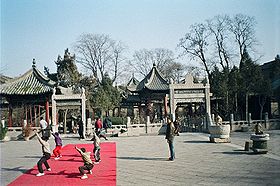- Martial arts practiced by Muslim Hui
-
A group of school children practice martial arts formation under the watch of their teacher in the Great Mosque of Xi'an.

The Hui started and adapted many of the styles of Chinese martial arts such as Bajiquan, Piguaquan, Liu He Quan, and other styles. There were specific areas known to be centers of martial arts, such as Cang County in Hebei Province.[citation needed]
- Huihui Shiba Zhou (Chinese: 回回十八肘 - "Hui elbow eighteen style") is reputedly a traditional style of martial arts practiced by the Hui. It was considered lost, but in 1970 it was announce that one Ju Kui, born 1886, was a living master of the style.[citation needed]
- Although bajiquan is not practiced exclusively by Hui, there are still many famous Hui practitioners of the style today, including Wu Lianzhi (the lineage holder of the style from Meng Village), Ma Xianda, Ma Lingda, Ma Mingda, and others.[citation needed]
- Zhaquan (Chāquán) is widely practiced throughout China, but particularly in Shandong and Henan, Zhaquan features graceful, extended movements, as well as various acrobatic maneuvers and many weapons. Famous Hui exponents of this style include Zheng He, an admiral of the Ming Dynasty,[citation needed] Wang Ziping, Ma Jinbiao, and Zhang Wenguang (who was instrumental in created the modern wushu version of Changquan).[citation needed]
- Qishiquan (Chinese: 七士拳 - "the seven warriors") was reputedly started among Chinese Muslims in Henan, and eventually reached Shanxi.[citation needed] The style, as the name implies, is based on seven essential postures from which sets are constructed.[citation needed]
- Xinyiliuhequan (Chinese: 心意六合拳 - "Mind, Intention and Six Harmonies Fist") is a martial art that developed in Henan province. Although practiced and preserved by the Chinese Muslim community in Henan, the style is recognized to be originated by Ji Longfeng (also known as Ji Jike ) of Shanxi province. The Shanxi transmission of this art is carried by the Dai family and transmitted to Li Luoneng, who modified the style more or less into the modern Xingyi practiced widely in Shanxi and Hebei. Since the Dai style Xinyi contains practice originated from the Dai family, the transmission within the Muslim community is considered the most conserved lineage.[citation needed]
- Piguaquan ("chopping and hanging fist") is generally believed to have been founded by Wu Zhong, a Chinese Muslim from Meng Village, Cang County, Hebei Province.[citation needed]
Wu initially learned the two styles from two Daoist monks Lai and Pi in 1727. Piguaquan is now widely practiced all over China, and features long-arm swinging and chopping techniques, some of which have been adapted and included in modern wushu forms (for example, wulongpanda (Chinese: 烏龍盤打)).[citation needed] Famous Hui practitioners of Piguaquan today include Ma Xianda, Ma Lingda, and Ma Mingda.
Notable Hui swordsmen
Further information: Chinese swordsmanship- The Muslim Chinese General Ma Hongkui personally wielded Dadao swords in combat during training with his troops. General Ma wielding a sword His soldiers also did sword dances with dadao during training.[1]
- The Muslim Chinese General Ma Zhongying made his Muslim troops of the 36th Division (National Revolutionary Army) engage in shadow fencing during practice.[2] During the Battle of Tutung, they used these swords to storm Russian machine gun posts.[3]
References
- ^ LIFE Nov 1, 1948 Ma Hung-Kwei
- ^ Christian Tyler (2004). Wild West China: the taming of Xinjiang. New Brunswick, New Jersey: Rutgers University Press. p. 109. ISBN 0813535336. http://books.google.com/books?id=bEzNwgtiVQ0C&pg=PA109&dq=ma+zhongying+parallel+bars&hl=en&ei=UXkaTJ3WBIXwNIPDyJ0F&sa=X&oi=book_result&ct=result&resnum=1&ved=0CDMQ6AEwAA#v=onepage&q=shadow-fencing%20parallel%20bars&f=false. Retrieved 2010-06-28.
- ^ Andrew D. W. Forbes (1986). Warlords and Muslims in Chinese Central Asia: a political history of Republican Sinkiang 1911-1949. CUP Archive. p. 120. ISBN 0521255147. http://books.google.com/books?id=IAs9AAAAIAAJ&pg=PA120&dq=soviet+GPU+troops&hl=en&ei=QuwWTLPEMoX7lwfu_pTjCw&sa=X&oi=book_result&ct=result&resnum=1&ved=0CCsQ6AEwAA#v=snippet&q=machine%20gun%20posts%20whilst%20wielding&f=false. Retrieved 2010-06-28.
Categories:
Wikimedia Foundation. 2010.

